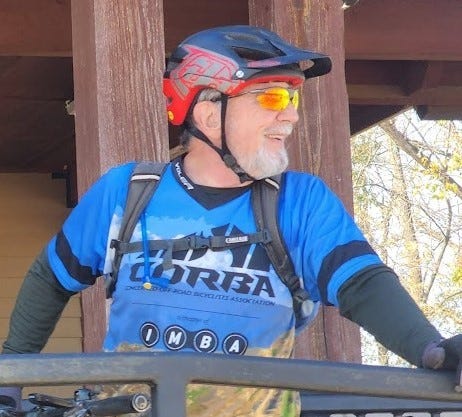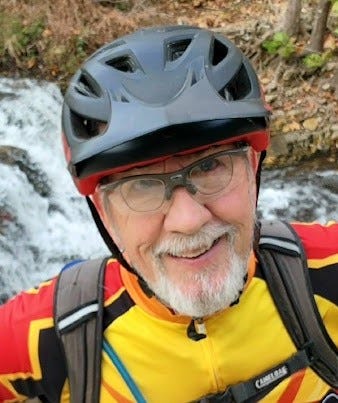Mountain Bike Hall of Famer Jim Hasenauer is back with the last installment of our year-long Q&A series with him. This time around, it’s on the future of mountain biking, as he sees it. What he says here/below requires slow reading, as it’s layered with so much history and insight. We all have a lot to learn, and we all have so many people to thank.
Many, many thanks to Jim for sharing his wisdom with MTBeer. I’ve heard numerous positive responses to what he’s said over this past year, but what if you shared your thoughts/thanked him yourself?! Drop a line in the comment box here:
The question this time around was simply about what the future of mountain biking looks like to Jim. His answer is long. Grab a favorite beverage, sit back and take it all in:
I struggled with this. Mountain biking is a worldwide sport with at least a half dozen disciplines. We have riders of all stripes and ages. Changes are happening in technology, in our community and in public land policy. Who the heck knows where it’s all going?
I’m definitely not the right person to ask about tech changes. I’ve always been surprised by the engineers. I didn’t anticipate front suspension, hydraulic brakes, titanium, rear suspension, disk brakes, carbon fiber frames, dropper posts, one by chainrings or any of the other innovations that are deemed standard today. Forget the changes in geometry. I’m the last to know. People are telling me that my 2016 S Works Stumpjumper is “old school”. Huh?
But here are two things I do know about our future here in the states. There will be many more trails and there will be many more riders. We have to build our organizations to deal with those opportunities and challenges.
The pioneers of the 70’s and the early riders of the 80’s inherited what seemed like an endless supply of existing fire roads and trails. Before the internet, these places were shared via the magazines and word of mouth at races and events. Early on, riders organized and stepped up to maintain those trails. It was easy to see where a small amount of trail building effort could connect two existing trails. Trail building became an essential component of mountain bike culture. In 1993, Alan Armstrong of the Mount Wilson Bicycle Association was the first rider to be inducted into the Mountain Bike Hall of Fame for MWBA’s trail work in the Angeles National Forest. I think the Ken Burton Trail was the first official new trail built by mountain bikers in the US.
Since then, our contribution to trail planning, construction and maintenance has been gigantic. Over the last 45 years, we’ve built thousands of miles of new trail and restored or maintained many thousands more. IMBA supported this from its inception. CORBA’s Kurt Loheit became IMBA’s trainer and traveled the country teaching clubs the fundamentals of trail work. This was followed by the Suburu Trail Care Crew which at one time had four teams of trainers helping local clubs. IMBA published two books that became the bible for trail building and mountain bikers pioneered design and construction improvements like grade reversals, rolling dips and armoring.. Eventually, IMBA created a division, Trail Solutions, that provided fee for service professional help to entities interested in building new trails. The Western States Trail Builders’ Association, once a bastion of hiker and equestrian trail builders who didn’t want anything to do with bikes, has morphed into the Professional Trailbuilders’ Association and the largest percentage of its leaders and members are mountain bikers who developed their skills as volunteers and now have hung out their shingles. Trail building is in our DNA.
Trails promote health, well-being and the local economy. The pandemic showed the world what a community resource trails are. In many places, officials realized they needed more. IMBA’s “Trails Close to Home” motto resonated and as of this year, with IMBA’s help, 70 communities have built new trail systems, 120 communities have systems in process, and there are close to 400 communities on a waiting list. Many more communities are doing this outside IMBA’s tent. Trail infrastructure is becoming as essential as swimming pools, basketball courts and ball fields and more federal and state funding is becoming available specifically for trails.
These shared use community trail systems are designed to serve all trail users, but cyclists are at the forefront of design and building. Sometimes bike trails are separated from hiking and equestrian use; sometimes directional trails clear the way for downhillers. The best systems have a place for everyone and they’re easy to access so short before-work, lunch or after-dinner outings are just out the door.
At the same time, there are some amazing new opportunities for long distance backcountry rides coming. There are plans in California to connect 15 towns and 600 miles of trail as the Lost Sierra Trail. The Oregon Timber Trail will offer a 700 mile route across the state. The 690 mile mostly off-road Cross-Washington Bikepacking Route offers a mix of roads and singletrack to traverse that state. There are many similar efforts. All would be helped by the Biking on Long Distance Trail Act which will likely be resubmitted to Congress next session.
Let’s not forget the proliferation of mountain bike destinations. Ski areas were among the first to build infrastructure and invite riders to come off season. Now almost all do and, in some cases, summer revenues outstrip winter’s. Park City Utah, long out front here continues to add miles to their system. Many towns and small cities are building trails and polishing up their amenities for riders. Oakridge Oregon; Copper Harbor, Michigan; Cuyuna Lakes, Minnesota and Bentonville, Arkansas were early to discover the economic benefits of attracting riders to high quality trail systems. Now they’re far from alone and they’re sharing their experience with other municipalities.
The growth in trail mileage is exponential. There will be many great new places to ride.
And there will be many new riders to ride them. I haven’t seen the data, but I suspect the pandemic brought thousands of new riders to our sport. For two years, riding a bike was one of the safest, most pleasant activities a person could do. I think many of these new riders will stay with us.
The boom in ebikes is allowing many of us to ride longer but also bringing thousands of new riders to the trails. No matter our individual opinions, ebikes are here to stay. We need to engage these riders as we plan and build trails.
Our organizations have always promoted youth programs. Usually these were motivated by riders wanting to share the joy with kids. Now these organizations, while underfunded, are well established and increasingly larger number of kids are being turned on to mountain biking. Trips for Kids, Sprockids, Take a Kid Mountain Biking, Youth Adventures, the Little Bellas and a range of other programs are introducing kids to the sport. As importantly, the kids are being mentored in nature appreciation and life skills.
Post pandemic, high school (and junior high) mountain bike racing teams are back in training and competition. NICA, the National Intercollegiate Cycling Association has created a pipeline of new, increasingly skillful riders, most of whom will become lifetime mountain bikers. NICA has 30 leagues and 25,500 active student athletes. Each of those kids brings parents, grandparents, aunts, uncles, and siblings along with them. It’s one of the best things that ever happened to mountain biking. It benefits the youth and the 14,400+ adults who work with them. It demonstrates the need for trails in their home communities because the kids need places to train and parents want the trails close enough they don’t have to drive them. From an advocacy perspective, youth testimony can turn the tide at parks boards and city council meetings. NICA is not alone either. There are several other independent high school racing programs out there.
One of the things that’s always been obvious about our community is that we’re overwhelmingly white and overwhelmingly male. That’s changing and will continue to do so. There are many more women in the sport since Wendy Cragg singularly rode with and photographed the boys in the 1970’s. Jacquie Phelan’s Women’s Mountain Bike and Tea Society set the table, but now there are large numbers of women riding and several organizations to support them. Wendy Engleberg of CORBA was a cofounder of Girlz Gone Riding that began with a few women in Los Angeles and has expanded to 4200 women in eight chapters in California and Arizona. Again, there are other groups. Almost every riding community has a woman’s club or at least women’s meet up rides. These women will continue to invite others into riding.
Our lack of racial and ethnic diversity is understandable but embarrassing. Our national organizations have committed to values of equity and inclusivity. We need to make that explicit at the local level. There is some good work being done. Organizations are proactively reaching out to diversify their leadership. Lately, there’s been an emphasis on building urban bike parks. The benefits are innumerable and it’s a great way to engage kids where they live. Here’s another place where high school racing is making a difference. It’s exciting to see teams from inner city schools or indigenous reservations joining the mix. Change is happening, but we have a long way to go be inviting and to share the love.
As we look to the future, we can expect thousands of miles of new trails and a vibrant, growing and diversified community of riders. If our organizations can focus that energy, we’ll have the potential to take on advocacy challenges at all levels. Let’s get to it.






Jim is a treasure. Honored to call him a friend and a mentor.
Jim has opened the trail door to so many. His passion and expertise both key. Im honored as well to have you as a friend. Thank you for making our outdoor world a better place.